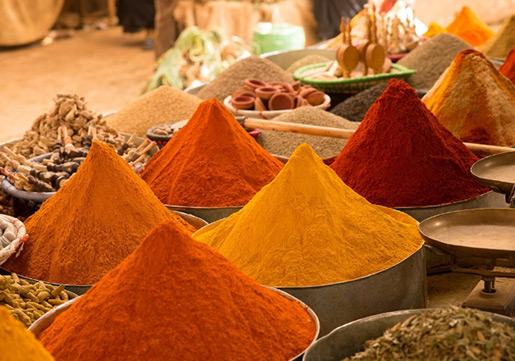10 Must Know Global Market Trends for Spices Exporters from India in 2025

If you’re a spices exporter from India, keeping up with global trends is key to staying competitive and growing your business. In 2025, the spice trade is evolving fast driven by health awareness, tech, sustainability, new buyers, and more. Here are ten game-changing trends every exporter should know:
1. Surge in Demand for Organic & Clean‑Label Spices
Consumers around the world are choosing foods labeled “organic,” “non‑GMO,” and “no additives.” Spices like turmeric, chili, and cumin grown without chemical residues are commanding better prices. Those spices exporters from India who invest in organic certification early are winning loyal buyers in markets like the US and EU.
2. Rising Interest in Health-Driven Spices
Spices such as turmeric (curcumin), cinnamon, and black pepper are now seen as functional foods. Buyers are ordering powders, extracts, or wellness blends. Offering standardized spice extracts or ready-to-use sachets helps spices exporters from India diversify and earn higher margins.
3. Emphasis on Transparency & Traceability
Buyers today want to know the full journey of their spices from farm to fork. Traceability technologies like QR codes, blockchain tracking, and full lab reports are becoming non-negotiables. Exporters embracing transparency are building stronger trust and brands.
4. Customized & Culinary Spice Mixes on the Rise
Simple single-spice exports are giving way to customized blends pizza seasoning, chai masala, global spice mixes. Many spices exporters from India are now offering product development and private-label packaging for international food companies.
5. New Buyer Markets Beyond Traditional Regions
While the US and Europe remain major buyers, emerging markets in Latin America, Southeast Asia, Africa, and the Middle East are opening up. These regions love Indian spices and are willing to explore new blends and variants. Many exporters are exploring these high‑potential markets in 2025.
6. Sustainable & Ethical Farming Practices
Sustainability is now a priority. Ethical sourcing, fair wages, reduced water use, and eco-friendly packaging (like compostable bags) are becoming buyer expectations. Exporters aligning with sustainable practices can attract long-term contracts and partner with conscientious brands.
7. Digital & E‑Commerce Channels Are Growing
Platforms like Alibaba, Amazon Business, and trade portals are helping exporters find international buyers directly without middlemen. Digital listing, webinars, and virtual demos are becoming common. Now, even small exporter from India companies can pitch live to buyers across time zones.
8. Food Safety Standards Are Getting Stricter
Global regulations are tightening whether it’s pesticide residue limits, heavy metal testing, or microbial criteria. Exporters are investing in lab testing, HACCP, ISO 22000, or FSSC 22000 certifications to ensure compliance and smooth customs clearance.
9. Cold Chain & Logistics Solutions Improving Quality
Improved shipping, storage, and cold chain solutions are helping preserve spice aroma, color, and shelf life. Exporters using vacuum-packed, moisture-proof packaging along with temperature‑controlled logistics are reducing losses and improving returns.
10. Government Support and Export Schemes
In 2025, Indian exporters benefit from schemes through APEDA, Spices Board, and export promotion agencies. Subsidies for trade fairs, infrastructure grants, and export certification support make it easier for exporters of all sizes to enter global markets.
What Does All This Mean for You?
If you’re a spices exporter, here’s how to act:
- Invest in certifying some key spices as organic.
- Offer value‑added products extracts, blends, sachets.
- Build traceability systems and share lab reports.
- Explore newer international regions.
- Adopt sustainable farming and eco‑friendly packaging.
- Use e‑commerce platforms to reach buyers globally.
- Stay ahead of food safety rules and get certified.
- Improve packaging and logistics to protect quality.
- Leverage government assistance to upgrade your offerings.
Final Thoughts
The global spice market in 2025 offers huge promise but only for those who adapt. Trends like health consciousness, sustainability, tech transparency, and new buyers are reshaping the trade. Spices exporters who embrace these changes will not just survive they’ll lead.
Now is the time to focus on quality, innovation, and customer trust. Invest in organic certifications, improve your supply chain transparency, and explore value-added products to meet evolving buyer needs. Don’t forget the importance of sustainable farming and eco-friendly packaging, as these are becoming top priorities for buyers worldwide. By staying informed and flexible, you can unlock new markets and build lasting relationships.
So take stock: Where can you innovate, certify, or improve today? With the right steps, you can build trust, increase margins, and ensure your place as a preferred global partner in the spices trade. Your proactive approach today will shape your success tomorrow.
- Art
- Causes
- Crafts
- Dance
- Drinks
- Film
- Fitness
- Food
- Games
- Gardening
- Health
- Home
- Literature
- Music
- Networking
- Other
- Party
- Religion
- Shopping
- Sports
- Theater
- Wellness


